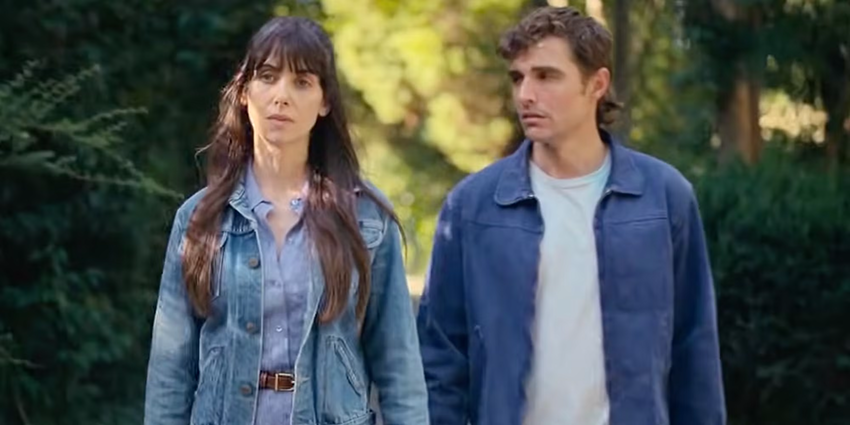In the Christian tradition we have always used the language of body horror to describe the implications of marriage. As early as in Genesis chapter 2 we read about marriage partners “becoming one flesh” – that’s an image that is completely at home in the same conversation as Cronenberg’s Videodrome or Brian Yuzna’s Society.
Australian filmmaker Michael Shanks has taken this literally with his debut feature film, Together. Starring real life married couple Alison Brie and Dave Franco, it follows them as a long-term but as yet unmarried couple escaping to the remote countryside to start a new life. Due to narrative reasons as silly and as pulpy as the excesses of genre films allow, they find themselves compelled towards each other in new and surprising ways. It starts with Franco’s Tim feeling unwell and panicked by Millie’s (Brie) absence, and progresses to his body being yanked around remotely by her movements at the wheel of her car. By the time the film has revealed its full hand, the couple’s bodies are literally magnetically attracted to each other, beginning to fuse together in ways that will be familiar to those fans of classic body horror cinema. Buzzsaws and secretive cults ensue.
What surprised me about Together was just how funny and sweet it was. For the regular filmgoer this might seem a contradictory statement. How on earth can a film about the distortion and perversion of the human body be considered funny or sweet? But as those who are more attuned to the vocabulary of horror cinema will no doubt already be familiar with, this is exactly what genre allows filmmakers to do. It takes the central idea of romantic relationships ending in the only logical outcome – the oneness of flesh – and uses genre trappings and tropes to externalise that idea in a way that is immediately and viscerally understood by audiences.
For some this lack of subtlety will be a hurdle. Whereas other horror films hide their metaphor under a shroud of mystery and suspense (Zach Cregger’s Weapons is a great example of this approach), Together shows the audience its hand of cards immediately. An effectively creepy prologue involving two dogs lets us know immediately what the “mystery” is, making the rest of the film less about piecing together the mystery than actually revelling in the images and iconography the metaphor allows.
These images are no doubt what the film will be remembered for by many; two bodies literally attracted to each other beginning to fuse in increasingly grotesque ways. But once the shock value passes, I actually think that Together is a surprisingly conservative narrative about the sanctity and beauty of marriage. If horror cinema is largely about catharsis, the catharsis that is found in Together is not rejecting or overcoming an external force of evil or darkness. It is found in the full and unconditional acceptance of another as not just a secondary person in your life, but an integrated and – to use Biblical language for a second – equally yoked part of your own life. No longer two separate entities, but a singularity. Two halves of a whole, only complete when together.
And to the film’s credit, it fully explores this idea with all of the tools at its disposal – whether those tools are from the toolbox of horror cinema or that of the classic romantic comedy. In fact, I think that the great success of Together is that beneath the genre excesses of bodily transformations and gory set pieces it stands on its own as a romantic film. Without the chemistry between its real-life couple and the smart, empathetic and genuinely funny writing, Together could well fade into the background of generic horror. But instead Together blends its horror trappings with genuine laughs and a romance narrative that takes itself seriously enough to allow the audience to buy in. It’s a combination of tones that many will be unfamiliar with, with grisly and stomach-turning bodily metaphors underlining a narrative of real warmth and love.
Depending how you read the film, you could come out of the experience feeling one of two ways. Either that the film is a celebration of a beautiful, lifelong connection that is forged in marriage, or a cautionary tale of the very same thing. I suspect that Michael Shanks is acutely aware of this, and has pushed the body horror elements as far as is possible to achieve this effect. Because at the end of the day, marriage is a bloody affair that isn’t for the faint of heart. If you can stomach it, it is a beautiful, magical thing. But if you’re not on board, from the outside it can seem truly horrific.
Jonty writes about film and narrative on his Substack, “Postcards from the Abyss.”
Together is in cinemas now.






